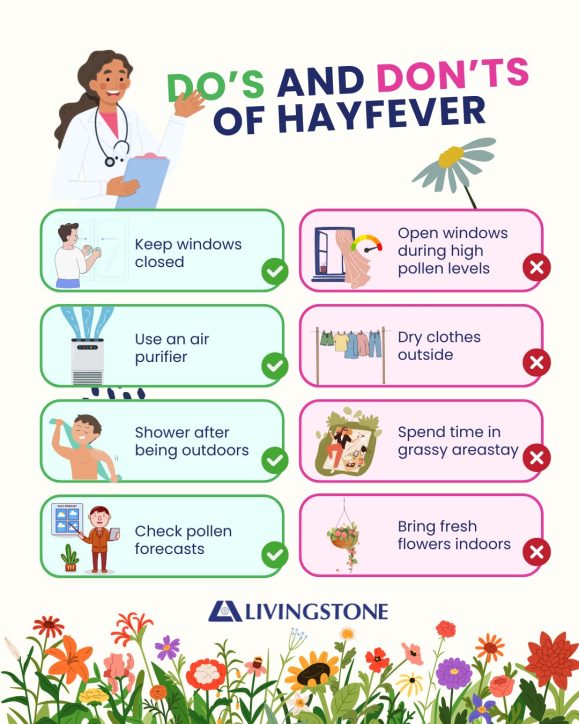Nearly one in four Australians now experience hayfever, making it one of the most common allergic conditions in the country. According to the Australian Institute of Health and Welfare, more than 4.6 million people live with allergic rhinitis, affecting sleep, concentration, and productivity, particularly during spring and early summer.
Hayfever is often dismissed as a minor irritation, but its symptoms can significantly impact daily life. Understanding what causes it and how to manage it effectively is essential to staying comfortable throughout the year.
What is Hayfever?
Hayfever, also known as allergic rhinitis, occurs when the immune system overreacts to harmless airborne substances such as pollen, dust mites, mould spores, or pet dander. When these allergens are inhaled, the body releases histamine, which triggers inflammation and irritation of the nasal passages.

Despite the name, hayfever does not involve hay or cause fever. It can occur seasonally, usually during spring and early summer when pollen levels are high, or perennially, when symptoms persist throughout the year due to indoor allergens.
According to Healthdirect Australia, hayfever is closely linked with asthma and eczema, meaning individuals who have one allergic condition are often more likely to experience another.
Common Symptoms of Hayfever
Hayfever symptoms can range from mild discomfort to persistent irritation that disrupts sleep and work. Typical signs include:
- Frequent sneezing
- Itchy or watery eyes
- Runny or blocked nose
- Itchy throat, mouth, or ears
- Post-nasal drip or a persistent cough
Fatigue or headaches due to nasal congestion

While these symptoms can resemble a common cold, hayfever tends to last longer and is not accompanied by fever or body aches. The symptoms also appear at specific times of the year or after exposure to allergens.
Treatment Options for Hayfever
Hayfever management involves reducing exposure to allergens and controlling the body’s reaction through medication or therapy.
Over-the-counter options:
- Antihistamines: These help relieve sneezing, itching, and a runny nose by blocking the effects of histamine.
- Nasal corticosteroid sprays: These reduce inflammation and are effective for congestion and persistent symptoms.
- Decongestants: These can temporarily relieve blocked noses but should not be used for more than a few days.
- Saline nasal rinses: These help clear allergens and mucus from the nasal passages.
Consult a medical professional
Prescription treatments:
For people with moderate to severe symptoms, doctors may recommend stronger corticosteroid sprays or combined treatments (such as antihistamine plus steroid formulations).
In some cases, allergen immunotherapy may be considered. This long-term approach gradually desensitises the immune system to specific allergens, reducing sensitivity over time. Allergy & Anaphylaxis Australia provides detailed information about this therapy and its potential benefits.
Hayfever Season in Australia
The timing and severity of hayfever symptoms depend on the type of pollen in the air and where you live. In southern regions such as Victoria, South Australia, and Tasmania, grass pollen peaks between October and December, while in Queensland and northern areas, pollen levels may rise earlier.
Climate change has also been linked to longer pollen seasons, meaning some people now experience symptoms well into autumn. Monitoring local pollen counts and understanding your regional triggers can help in planning preventive care.
Proactive Measures to Reduce Hayfever Symptoms
Preventive measures can significantly reduce exposure to allergens and make treatment more effective.
Practical tips include:
- Keep windows closed during high pollen times, especially in the morning and on windy days.
- Use air purifiers and replace filters regularly.
- Shower and change clothes after spending time outdoors.
- Avoid hanging clothes or bedding outside when pollen levels are high.
- Vacuum and dust frequently using HEPA-filtered cleaners.
- Start medication or nasal sprays a few weeks before the pollen season begins.
Proactive care helps control symptoms before they escalate and ensures better day-to-day comfort throughout the allergy season.
Living Well with Hayfever
Hayfever can be effectively managed with the right combination of avoidance, medication, and medical support. Regularly reviewing your treatment plan with a healthcare professional ensures that symptoms remain under control and side effects are minimised.
With a proactive approach, millions of Australians are able to enjoy the outdoors, manage their allergies effectively, and maintain a high quality of life even during peak pollen seasons.
References
- Australian Institute of Health and Welfare (AIHW) 2024, Allergic rhinitis (hay fever): Impact of allergic rhinitis, Australian Government, viewed 13 October 2025, https://www.aihw.gov.au/reports/chronic-respiratory-conditions/allergic-rhinitis-hay-fever/contents/impact-of-allergic-rhinitis
- Allergy & Anaphylaxis Australia 2024, Allergic rhinitis treatment, Allergy & Anaphylaxis Australia, viewed 13 October 2025, https://allergyfacts.org.au/allergic-rhinitis-treatment
